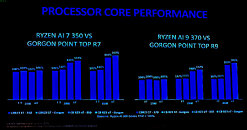
ASUS Introduces ROG Strix & TUF Gaming GeForce RTX 5070 Laptops
ASUS Republic of Gamers (ROG) announced the arrival of new configurations of its popular and acclaimed Strix line-up as well as the new ASUS TUF A18—now available for pre-order. Both ASUS' and ROG's cutting-edge line-up involves the latest from NVIDIA, with innovative graphics technologies like DLSS 4 and Frame Generation to enjoy ray tracing at more accessible price points. Our line-up available for pre-order includes both Intel and AMD equipped ROG Strix G16 or ROG Strix G18 as well as our refreshed TUF 16 and new TUF A18—the first 18-inch laptop in the TUF Gaming line-up. These will be made available at our select retail partners for pre-order.
ROG Strix G16 & G18 (Intel): Empowering Every Gamer
Designed to unite squads and elevate gaming experiences, the ROG Strix G18 deliver fast AAA gaming performance and seamless content creation, powered by Intel Core Ultra 9 Processor 275HX. Paired with up to NVIDIA GeForce RTX 5070 Laptop GPUs, these devices offer unmatched performance and stunning graphics. With up to 32 GB of DDR5 RAM, they ensure smooth multitasking and efficient handling of resource-intensive applications. The advanced Tri-Fan Technology, full-width heatsink, and full-surround vents provide exceptional thermal management, allowing users to maintain peak performance during intense gaming sessions. Both models are equipped with dual PCIe Gen 4.0 SSD slots and designed for tool-less access, with Intel models supporting PCIe Gen 5 on one of the slots for Strix G this allows for seamless storage upgrades. With customizable hotkeys for quick access to essential functions, the ROG Strix G18 empowers gamers to rise to victory.
ROG Strix G16 & G18 (Intel): Empowering Every Gamer
Designed to unite squads and elevate gaming experiences, the ROG Strix G18 deliver fast AAA gaming performance and seamless content creation, powered by Intel Core Ultra 9 Processor 275HX. Paired with up to NVIDIA GeForce RTX 5070 Laptop GPUs, these devices offer unmatched performance and stunning graphics. With up to 32 GB of DDR5 RAM, they ensure smooth multitasking and efficient handling of resource-intensive applications. The advanced Tri-Fan Technology, full-width heatsink, and full-surround vents provide exceptional thermal management, allowing users to maintain peak performance during intense gaming sessions. Both models are equipped with dual PCIe Gen 4.0 SSD slots and designed for tool-less access, with Intel models supporting PCIe Gen 5 on one of the slots for Strix G this allows for seamless storage upgrades. With customizable hotkeys for quick access to essential functions, the ROG Strix G18 empowers gamers to rise to victory.





































